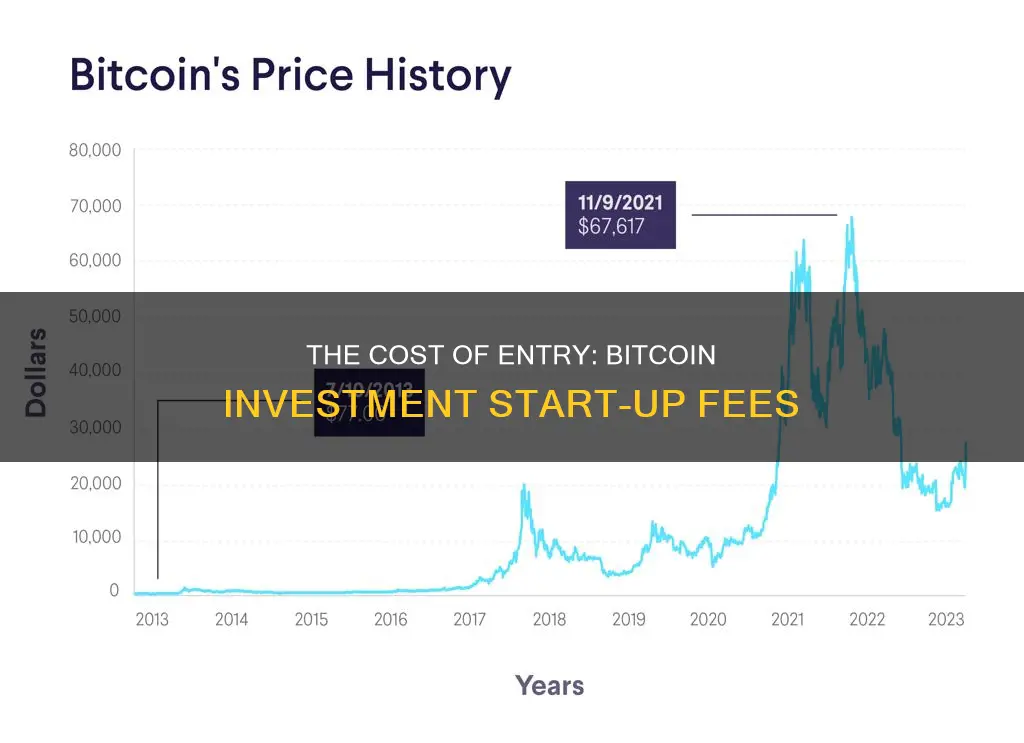
Bitcoin is a cryptocurrency, a virtual currency that uses peer-to-peer technology to facilitate instant financial transactions without the need for a central authority such as a bank. It was introduced to the public in 2009 by an anonymous developer or group of developers using the name Satoshi Nakamoto. Bitcoin is a highly volatile asset, prone to large and fast swings in value, which presents an opportunity for large returns but also poses tremendous risk.
To start investing in Bitcoin, you will need personal identification documents, bank account information, and a secure internet connection. You can then join a Bitcoin exchange, get a Bitcoin wallet, and connect your wallet to your bank account. You can purchase Bitcoin directly from an app like Coinbase, or from a cryptocurrency exchange. The big question is, how much Bitcoin should you purchase? Some coins cost thousands of dollars, but exchanges often allow you to buy fractions of a single coin—your initial investment could be as low as $25.
| Characteristics | Values |
|---|---|
| Personal identification documents | Driver's license, Social Security card, passport |
| Bank account information | Bank account, debit card, or credit card |
| Secure internet connection | Private Wi-Fi network |
| Cryptocurrency exchange | Coinbase, Binance, Kraken, Gemini, Bitfinex |
| Hot wallet provider | Electrum, Mycelium |
| Cold wallet provider | Ledger, Trezor, KeepKey |
What You'll Learn

Choosing a Bitcoin exchange
There are several different exchanges that facilitate Bitcoin transactions. These exchanges are the middlemen of cryptocurrency investing, like a stock brokerage. If you decide to purchase from an exchange, you’ll have to decide which exchange you want to buy from. Here are some of the most popular options:
Coinbase: Coinbase is a very popular crypto exchange that insures losses in the event of a security breach or fraudulent transfers. It also allows investors to take “physical” ownership of the asset. That’s an important distinction to make, as Coinbase allows investors to actually buy Bitcoin and store it in their own encrypted wallets.
Binance: Founded in 2017, Binance is a crypto exchange with a strong focus on altcoins.
Kraken: This San Francisco-based exchange allows you to invest in Bitcoin using various currencies from around the world. It offers the most order types, including market, limit, stop-loss, stop-limit, take-profit, and take-profit limit orders.
Gemini: Launched in 2015 by Cameron and Tyler Winklevoss, Gemini offers services for casual and veteran Bitcoin investors with different user interfaces and fee structures.
Bitfinex: Bitfinex is the longest-running cryptocurrency exchange, optimized for advanced traders and lenders. Unfortunately, Bitfinex doesn't currently accept US customers.
As you might have guessed, choosing a Bitcoin exchange is becoming more difficult for investors as more options begin to popularize.
Investing in Bitcoin: Is $100 Enough to Get Started?
You may want to see also

Getting a Bitcoin wallet
Choose the Right Bitcoin Wallet for You
The type of Bitcoin wallet you choose will depend on your needs and preferences. Here are the main types of Bitcoin wallets:
- Hosted wallet: This is the most popular and easy-to-set-up option. When you buy crypto through an app or exchange, such as Coinbase, your crypto is automatically stored in a hosted wallet. It is similar to a bank account, where a third party keeps your money secure. The main benefit of a hosted wallet is that if you forget your password, you won't lose your crypto. However, a drawback is that you may not be able to access all the features that crypto has to offer.
- Non-custodial wallet: This type of wallet gives you complete control over your crypto, and you are responsible for storing and safeguarding your password or private key. If you lose your private key, there is no way to recover your crypto. Non-custodial wallets do not rely on a third party, so your crypto is protected even if the third party is compromised.
- Hardware wallet: A hardware wallet is a physical device, similar in size to a thumb drive, that stores your private keys offline. Hardware wallets offer increased security, especially if your computer is hacked. However, they tend to be more complex and costly, and they are less convenient to use than software wallets.
Set Up Your Bitcoin Wallet
The process for setting up your Bitcoin wallet will vary depending on the type of wallet you choose. Here are the general steps:
- For a hosted wallet, choose a platform you trust, create an account with a secure password, and consider enabling two-factor authentication for added security.
- For a non-custodial wallet, download a wallet app (such as Coinbase Wallet), create your account, and write down your private key in a secure location.
- For a hardware wallet, purchase the hardware from a reputable brand (such as Ledger or Trezor), install the necessary software, and transfer your crypto to the wallet.
Transfer Crypto to Your Wallet
Once you have set up your Bitcoin wallet, you can start using it to store your crypto. If you already own crypto, you can transfer it to your new wallet. If you don't have any crypto yet, you can buy it through an exchange or app and have it sent directly to your wallet.
Security Considerations
When creating your Bitcoin wallet and transferring crypto, it is essential to prioritize security. Here are some tips to keep your crypto secure:
- Use a strong password or passphrase for your wallet.
- Enable two-factor authentication for an extra layer of security.
- Keep your private keys or seed phrases secure and do not share them with anyone.
- Practice safe internet browsing habits to protect yourself from malware and phishing attempts.
- Regularly back up your wallet to ensure you can recover your crypto if needed.
Remember that the security of your Bitcoin wallet is crucial to protecting your investment. By following these steps, you can securely store your Bitcoin and other cryptocurrencies.
Bitcoin Investment: Safe or Risky Bet?
You may want to see also

Connecting your wallet to a bank account
- Choose a Bitcoin wallet: There are two main types of Bitcoin wallets: hot wallets and cold wallets. Hot wallets are online or software-based wallets provided by your cryptocurrency exchange or a third-party provider. They are convenient for accessing your coins but may be less secure. Cold wallets, on the other hand, are physical hardware devices that store your coins offline, providing greater security. Examples of hot wallets include Electrum and Mycelium, while popular cold wallets typically cost between $60 and $100.
- Obtain your wallet: After deciding on the type of wallet that suits your needs, you will need to obtain it. For hot wallets, this may involve signing up with a cryptocurrency exchange or a third-party provider. For cold wallets, you will need to purchase the hardware from a reputable source.
- Connect your wallet to your bank account: This step will enable you to buy and sell coins by linking your wallet with your bank. You can do this by providing your bank account information, such as your account number and routing number, within the wallet app or platform. Alternatively, you can link your bank account directly to your cryptocurrency exchange account, especially if you plan to buy and sell coins frequently.
- Two-factor authentication: For added security, enable two-factor authentication when connecting your wallet to your bank account. This will require both your wallet password and a verification code sent to your mobile device.
- Transaction fees: Be mindful of transaction fees when connecting your wallet to your bank account. Fees may vary depending on the exchange and payment method used (e.g., bank account, debit card, or credit card). These fees are typically charged per transaction and can impact your overall profits.
- Security considerations: Connecting your wallet to your bank account provides convenience, but it also increases the risk of hacking and fraud. Ensure your private keys are secure, use strong and unique passwords, and consider additional security measures like multifactor authentication. Remember that hot wallets are more susceptible to hacking than cold wallets.
Bitcoin Mining: Worth the Investment?
You may want to see also

Placing your Bitcoin order
Now you're ready to purchase Bitcoin. Your cryptocurrency exchange will have everything you need to buy. The big question is, how much Bitcoin should you purchase?
Some coins cost thousands of dollars, but exchanges often allow you to buy fractions of a single coin—your initial investment could be as low as $25.
Investing in Bitcoin is very risky, and it’s important that you carefully determine your risk tolerance and review your investment strategy before you purchase any Bitcoin.
You can purchase bitcoin from cryptocurrency exchanges. Many offer dozens of cryptocurrency choices, while others simply have Bitcoin and a few alternatives. They carry a variety of different fees and consumer protections, so do your due diligence before choosing. Cryptocurrency exchanges where you can purchase bitcoin include Gemini, Kraken, Coinbase, Crypto.com, Binance, Bitfinex, and Robinhood.
You can also use a credit card to purchase Bitcoin, but it's best to avoid taking on high-interest debt to invest in a risky asset like Bitcoin. If the value of Bitcoin sinks, you could get stuck with big losses.
If you're using cash, you may wind up using a third-party service such as MoonPay to fill your order. Such services can cost a bit more than regular exchanges but offer some advantages in the form of quick, relatively painless transactions.
Bitcoin ATMs act like in-person bitcoin exchanges. Individuals can insert cash into a machine and use it to purchase bitcoin, which gets transferred to online wallets for users. Bitcoin ATMs have become increasingly popular in recent years and are available at Walmart.
Bitcoin vs Bitcoin Cash: Which Crypto is the Better Investment?
You may want to see also

Managing your Bitcoin investments
- After you've purchased Bitcoin, you can use your coins to make online transactions, hold your coins for a long period in the hopes that they will appreciate in value, or perform day trading with your coins. Day trading involves buying and selling coins with other Bitcoin owners, which can be facilitated on a cryptocurrency exchange.
- Be aware of the risks involved with investing in Bitcoin, including regulatory risk, security risk, insurance risk, fraud risk, and market risk.
- Consider diversifying your investment portfolio to protect yourself from marketplace volatility. Start with low-risk investments like government bonds or index funds, then move on to medium-risk investments like real estate or corporate stocks, and finally allocate a small portion of your portfolio to high-risk investments like Bitcoin.
- Understand your risk tolerance and carefully review your investment strategy before purchasing any Bitcoin. Bitcoin is a very high-risk investment due to its volatile nature.
- If you're purchasing a large amount of Bitcoin, be prepared to capitalise on market surges by selling your coins for a higher value when there are lots of buyers.
- Be cautious of "pump-and-dump" schemes, where predatory investors reach out to amateur or unassuming investors and convince them to invest large amounts of money into Bitcoin. These schemes can cause the value of Bitcoin to increase rapidly, but then drop to extremely low prices once investors stop buying.
- If you're unsure about investing in Bitcoin, start small. Consider investing a small amount each week to dip your toes in without taking on too much risk.
Bitcoin vs. Ripple: Why Invest in Bitcoin?
You may want to see also







